|
TennisOne Lessons
Learning Models: Pull/Push Versus Swing Doug King We are all familiar with the adage that "a picture is worth a thousand words." Almost everyone accepts the notion that tennis should be taught and learned visually. I think that visual learning is the easiest and most comprehensive way to learn. It is a very logical first (and mercifully final) step: "watch me and copy." If after the "watch and copy" method the action is reproduced perfectly, there is no reason to add anything more, just practice. Further instruction may be totally unnecessary and even detrimental. The point in learning tennis is to master a "kinesthetic response;" that is, to learn to produce a neuro/muscular movement or action. This is something that is felt, not visually seen, not logically understood, but rather something that is understood and executed in the nervous system and the tissues and fibers of the body. But what about the instances when we don't learn visually?" The unfortunate truth is that the tennis stroke can be very complicated. The stroke is not a "picture" but a moving, changing flow of very diverse and intricate actions. As true as the notion of "a picture being worth a thousand words" is the flip-side caution, "looks can be deceiving." Any sleight-of -hand artist knows just how easy it is to make something look very different than it actually is. We typically "see" only what we are looking for and what we look for can be determined by what we are told we are seeing. Another reality is that we don't "see" ourselves play so how do we really know what we look like? We are not watching ourselves play but we are "feeling" ourselves play. We feel the game in our feet and in our hands, in our breath and in our muscles.
Limitations of Visual Learning Although visual learning provides the greatest input in our learning process, there are distinct limitations. They include:
As a result of the limitations to a purely visual approach, we must also rely on words, phrases, and physical associations. The task at hand is not to "look" a certain way but to "feel" a certain interaction between the ball and the racquet. In order to do this you will often need to employ a "learning matrix' that combines many different learning models — visual, lingual, and physical. Video analysis has made a major impact on sports. It has taken some of the mystery out of what we are seeing. Gil de Kermadec of the French Tennis Federation set the standard for video analysis with his seminal series of in depth study of top players in the 80's. Later Vic Braden took video analysis to the masses. Further advancements with high speed video have given us an improved "view" of what we are actually seeing. We now have an opportunity to make significant improvements in our understanding of the stroke mechanics and the models that we use to teach and learn those skills. Still we cannot always capture "feeling" through a visual medium. Can we "see" how firmly Federer grips his forehand at contact, how much tension he holds in his shoulders while he turns? Can we tell what Sharapova feels in her gut, her shoulders, and her legs on a serve? Words can sometimes fill in the less visible elements. They can help us to understand what we are "seeing." Associated physical actions can help us develop reference and a better "motor vocabulary." In this article I want to show a very real example of how our models can influence our paths to learning and perceiving our strokes. I will try to show how our common and casual approaches to the stroke, both visual and verbal, can be limitations to our ability to learn Pull/Push versus Swing It is easy to be misled by what we see and what we hear when trying to learn the game of tennis. At the same time I want to expose some common misconceptions and further an alternative expression or model.
A flawed approach can start as casually and innocently as hearing a misleading phrase, comment, or even word. Sometimes I cringe at what I hear some announcers say when talking about players' strokes. They have good intentions but they aren't always careful about considering how lay people interpret what they say. These casual words can form the mental image that establishes an indelible stroke impression. For example, one of my pet peeves is that we commonly use the word "swing" in reference to strokes (and yes, I make the same mistake if I'm not careful). When we use the word swing, the most obvious image that is brought to mind is a playground swing. We are all familiar with the feeling of that kind of swinging and that naturally becomes our reference for stroke association. A "swing model," like the playground swing, is based on a fixed post or support or a center point, which an object attached by a tether then flies around. In a swing action we basically have one fixed end and another wildly circulating object. Speed and distance are constant and energy is released in a circular arc. Combine this word association (tennis swing and playground swing) with what the casual observer sees when he looks at a top player hitting a ball (which can easily be seen as a very fast, whippy, "swingy" looking motion) and you have the basis for a misleading stroke concept. Once you start down this path, it can be very difficult to change your course. No matter how much you try to modify a "swing" ("shorten you backswing!"), you can still be limited by the conceptual framework of a "swing" model. Compare a "swing" approach with a "pull and push" conceptual approach. "Pull and push" can almost be considered as a polar opposite approach from a "swing." With the "pull and push" we do not have a continuous action but instead we have two opposing actions. With the pull and push model, we start by drawing (storing up potential) energy into the body with a pull, and then we transfer it onto another object through a push. A swing does not involve this gathering and transferring of energy but a simple collision of two objects. A pull and a push are much more linear in nature; a swing is circular. A pull and a push are much more deliberate, controlled actions based upon resistance, stored energy, leverage, alignment, connection, and transfer, to name only some of the principles. The "pull and push model" is more accurately represented with the preferred term, "tennis stroke," rather than "tennis swing." We stroke a cat, we stroke paint to a canvas, and we stroke a tennis ball - but we definitely do not swing at them. Many people might argue that I am nit-picking here but I would counter by saying that the tennis stroke is a complex act and it is critical that we approach it with clarity and precision. Not only should we use the correct terminology but we should also understand the precise differences between a swing and a stroke. I am not advocating adding more information to the learning process than is necessary, but instead finding the most powerful and effective words and phrases that communicate the correct impressions, feelings, and responses. This will allow an individual to progress with the least amount of setbacks, obstacles, and relearning. Now lets look more closely at the "pull and push" model and see how this concept may change how you approach stroking. Analyzing the Pull and the Push Actions We have commonly described the tennis stroke as a smooth, fluid, continuous motion. I would caution against this depiction. I prefer to break it down into two separate actions, those being the "pull" and "push." You could also refer to it as "load and unload," "slot and trigger," or "cock and fire." The point is that there is not a simple racquet back and swing out at the ball, but a pulling or loading phase followed by a pushing or releasing phase. In fact the secret to proper power is the ability to make this transition between pulling and pushing as extreme and sudden as possible, rather than trying to execute a smooth, continuous stroke action. This dramatic shift between pulling and pushing creates acceleration. Acceleration is critical to the proper transfer of energy. The object of the pull is to gather energy for the push. The correct pull technique is not a forced movement but more of a controlled "folding-in" or "collapsing arm" action with the purpose of gathering energy into the body. This gather of energy is a forward pull of the elbow as the wrist loosely folds while the forearm rotates back (supination). This gathering and releasing of energy is based upon movement and controlled resistance which results in natural acceleration of the arm. We can see this in the simultaneous elbow forward/ racquet back coiling action (supination) typical of groundstroke and service actions where power is desired. Not only does this pull bring the arm into stronger position to the body, it also shortens the radius of the arm which will allow it to move more quickly. In addition, the loosened wrist will allow the possibility of contributed speed from the hand.
As we meet the ball and drive through it, we enter into a “pushing phase.” Whereas pulling is drawing energy from outside of the body and bringing it into the body, pushing is transferring the energy from inside the body onto another object and moving it away. This is a release that is both propulsive in nature but also, just as importantly, it is directional in nature. Typically when we use the word “push” in describing a tennis stroke we discard the notion as a relatively inferior, weak stroking action. Looked at differently, the push can be regarded as a highly nuanced exchange of energy between two moving objects. Think of the “pull and push” action as breathing. The inhale pulls oxygen into the lungs and then the exhale expels it. The deeper the inhale the more powerful the exhale. The pull and supination is part of the inhale of your swing and the push and pronation is the exhale. Look at the example of how I push away the cart in the above video and consider what is happening. As the cart approaches and I prepare to push it away, there is a loading of energy into the body by bending and flexing, bringing my body and my arm into a strong position relative to each other and to the cart, and supported by the ground. As I contact the cart, my hand must meet the cart by aligning to it, shaping and molding to create a connection or engagement between the cart and me. Not only does my hand conform to the cart but it also aligns to the target/direction that I am pushing the cart to. Then there is a release of energy, starting in the ground and working through the body and out of the shoulder and arm. My hand then follows the cart for as long as possible and directs it as energy is transferred through this connection. This is a simple but hardly crude movement. In fact, in my mind, the push encompasses all of the subtleties of a proper stroke. The four crucial advantages to the Pull/Push technique are:
Of course the pull and push has its limitations in explaining or describing the tennis stroke, as does any model. No single word or phrase is going to capture the entirety of the stroking action. The interpretation of words is also very subjective. But, in my opinion, it is far superior than simply saying “swing.” It is something that is simple, familiar, and relatively precise. To qualify the phrase by saying a “fluid pull and a forceful push” is better. To be more descriptive about the pull and push; to say “smoothly pull the butt of the racquet forward like you are pulling a sword out of a scabbard,” and to say “push with your shoulder and roll with your hand like a windshield wiper” may be better still, adding turn, or spin to the ball and recovery to the movement. However you choose to qualify the terms, one must keep in mind that enough liberty must be left in the process to allow the player to develop a range of feels necessary to be effective. How the Pros Do It: The Pull In The pros consistently do two things much differently than average players. One, they continue to coil and store energy for a longer period of time as they approach the contact of the ball. Two, they release that stored energy onto the ball in a more concentrated and unified moment. Most players feel that once they turn and get the racquet back they are ready to swing out at the ball. Once they complete the backswing and transition into the forward movement of the stroke they begin to release enegy at the ball.
The pros, on the other hand, turn and take the racquet back in a similar way; however, when they proceed forward to the ball and they will stay in the loading phase of their stroke. They will continue to coil, compress, and build up tension almost until the point of contact. As they move forward to the ball, the elbow will be pulled in and forward while the racquet will be held back. This backward turn of the racquet and forearm will act as the resistance that continues to build up tension/stored energy in the arm and shoulder until the last possible moment. In a sense, the pros do not actually take the “racquet back” until this fold back in the wrist, which can occur relatively late in the swing. This is because the hand is the where we actually feel the racquet. We do not feel the racquet in our feet or in our hips but in our hands. And this folding back of the racquet, when timed a bit later in the stroke, helps to keep the motion more dynamic, resulting in more acceleration. Of course, this does not mean that this is where the backswing starts – it is just that this is where the hand “feels” the most flexing back of the racquet. This is true for all power strokes, groundstrokes, serves, overheads. What lesser players tend to experience is the urge to feel the racquet moving forward instead of back. They want to feel speed in the racquet, and so they tend to release energy much earlier. They associate racquet momentum with power. This creates more swing and it undermines the crucial acceleration which occurs in the spilt second transition from the pull to the push. The result of this premature energy release is a breakdown in timing, leverage, and alignment. We refer to this as “over-swinging”. I tell my students that at the moment that they feel like they should swing out at the ball that instead, they should fold the wrist back further and pull the arm in even closer, and then drive through the ball, almost too late.
The Push Out The second thing that the pros do better than lesser players is to release power more decisively – they push harder, more quickly, and more cohesively at the moment of contact. Everything fires a little more quickly and in better sequence, starting with the legs and working through the back, shoulders and arm. Although it is still a rhythmic, controlled release, it is almost a singular firing rather than a deliberate or forced movement. They do not “spray” energy, which is an inherent defect of a swing action. Instead, they focus the energy release on the ball itself – in the execution of a forceful, directional push and turn of the ball, instead of focusing on a more arbitrary follow through position. The ultimate aim is not to produce a swing form, but a concentrated moment of connection with the ball – a moment of focused energy, alignment, and connection between the racquet, body, and the ball into a dynamic burst of energy. This final moment of drive is felt in almost every part of the body and not just in the racquet. In fact many times the racquet must be “contained” to allow everything to contribute properly.
So instead of making the swing more “even”, or “continuous,” the pros actually have more “range” in their stroke. They are able to reach to the extremes on the spectrum between pulling and pushing rather than finding something in the middle. And they can fluidly combine these two distinct actions with balance, timing, and control. In fact it is in the combining of the pull and the push, the transition moments between the two, which the critical event occurs. Conclusion I have tried to describe the basis of a stroke action in the context of a “pull and push” model. Of course, whatever learning strategy we decide to use, there is no system, no picture, no description, no formula that can cover the huge range of different strokes that constitute the range of shots we encounter or the style of play that we see executed. A “pull” may be smooth and relaxed, or quick and even whip-like; a “push” may be more solid and from the body while another may be a faster, and also whip-like; but the concept of a pull and a push better describes the actual exchange of energy between the player and the ball than the common swing metaphor. Within this study of the “push/pull model” I have also tried to argue the value of a “learning matrix”; a layered approach to learning that includes visualization, lingual explanation, and physical associations. Our learning can improve as we add diversity to how we learn, however care should be taken to insure that all systems support one another with clarity and consistency. We are in an incredibly exciting time of learning and communicating. The developments in sports science and technology have made a tremendous impact on how we approach sports analysis and how we can communicate that knowledge into learning models. Hitting the tennis ball has seen an evolution spurred by professional players, sports science, and technology as has every other sport. In the same way, how we communicate that knowledge and make it accessible to more people also continues to develop. Much as the tennis stroke is based upon a delicate synthesis of varying feels and movements, so should our learning process include a wide range of varying input. Video, the written word, the spoken word, observations, associations, and hands on physical exercises all encourage and educate us. The computer and the internet have played a huge part in the creation of this rich learning environment. By integrating these models, I believe we can create the most powerful teaching, learning, and communicating system ever. From a visual standpoint we can “see” things that before we could only guess at. From there we can begin to describe more accurately what we see and be more discerning in the ways that we communicate that insight. Ultimately we can develop better learning strategies to everyone’s benefit. Your comments are welcome. Let us know what you think about Doug King's article by emailing us here at TennisOne.
Doug is one of the country's foremost tennis teaching innovators. Founder of Acceleration Tennis, a revolutionary teaching system, King is leading the way in reinterpreting the traditional tennis model. Doug King is currently Director of Tennis at Meadowood Napa Valley ( www.meadowood.com ), a Relaix Chateau Resort in St. Helena , CA . For more information on Acceleration Tennis please email Doug King at dking@meadowood.com. |

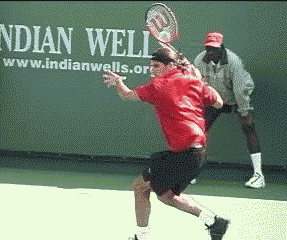
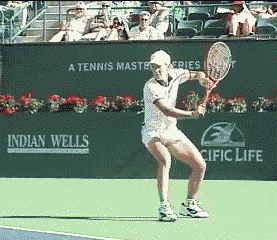
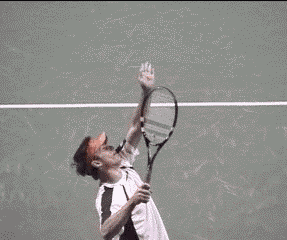
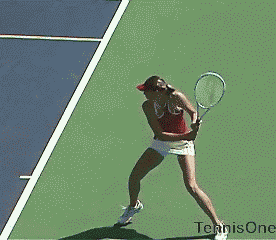
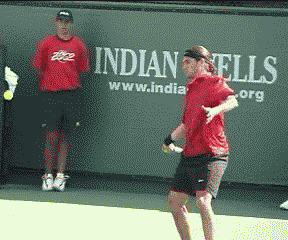
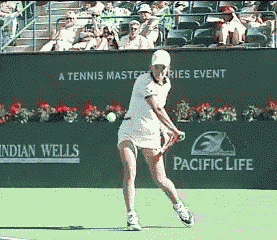
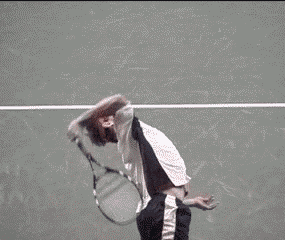
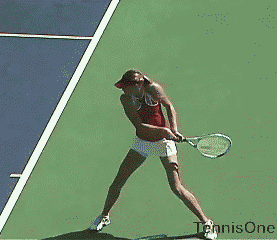
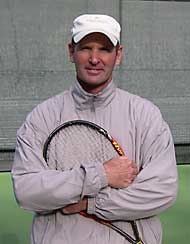
 Doug King studied with legendary tennis coach Tom Stow and was a
former California State Men's Singles Champion
and the former number one men's player of Northern California.
Doug King studied with legendary tennis coach Tom Stow and was a
former California State Men's Singles Champion
and the former number one men's player of Northern California.